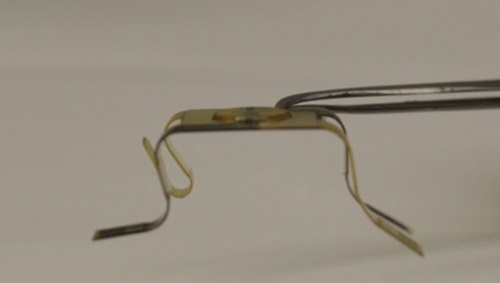HC Plastics News: As 3-D printing technology has become a mainstream manufacturing technology, industrial and academic researchers have been working on a printable structure that spontaneously folds into useful three-dimensional shapes after heating or immersion in water. .
In a paper published in the Journal of Applied Chemistry and Interfaces of the American Chemical Society, researchers at the Massachusetts Institute of Technology's Computer Science and Artificial Intelligence Laboratory (CSAIL) report some new discoveries: once they are from the print platform A printable structure that begins to fold on itself when peeled off.
One of the great advantages of the devices that can fold on their own without any external stimuli is that they can be applied to more materials and finer structures, the researchers said.
A printable structure that is self-folding once removed from the printing platform by a new method. Image source: Massachusetts Institute of Technology
Subramanian Sundaram, first author of the article, MIT electrical engineering and computer science student, said: "If people want to add some printed electronic components, they usually use some organic materials, because most printed electronic components rely on organic materials. However, these materials are often very sensitive to humidity and temperature, so if your electronic components and parts need to be folded, you certainly don't want to immerse them in water or heat them, as these operations can significantly degrade the performance of the electronics."
To illustrate this idea, the researchers constructed a prototype of a self-folding printable device that included electrical leads and polymer "pixels" that changed from transparent to opaque when a voltage was applied. The device is a variant of the "printable gold beetle" announced by Sundaram and colleagues earlier this year, which starts to look like the letter "H." However, each leg of H is folded in two different directions at the root and the middle to form a table top shape.

To show that they can precisely control the angle of joint folding, the researchers also made several different versions of the same shape with the same hinge. In the test, they forced the hinge straight by fixing the hinge to the negative load, and when the load was removed, the hinge returned to its original folded state.
It is expected that in the short term, the technology will enable the refinement of sensors, displays or antennas, and the resulting product functionality will depend on their three-dimensional shape. In the long run, researchers believe that it is possible to make printable robots.
Sundaram added some suggestions from his mentor, Wojciech Matusik, associate professor of electrical engineering and computer science (EECS) at MIT; Marc Baldo is also an associate professor at EECS, specializing in organic electronics; DavidKim is Mattrick's Computational Manufacturing Technical Assistant; Ryan Hayward is Professor of Polymer Science and Engineering at the University of Massachusetts Amherst.
Stress relief
The key to the designer's design is a new type of printer ink that expands after solidification, an unusual feature. Most printer ink materials shrink slightly when cured, which is a technical limitation that designers often face.
Printing equipment is typically layered, and in the printed prototype, MIT researchers deposit the expanded material at precise locations on the top or bottom layers. The bottom layer will adhere slightly to the printer platform and will have sufficient adhesion to keep the device flat when the layers are assembled. However, once the completed device is stripped from the platform, the joint made of the new material will begin to expand, bending the device in the opposite direction.
As with many previous technological breakthroughs, the discovery of this new material is an unexpected surprise for researchers in computer science and artificial intelligence laboratories. Most of the printer materials used by the Matrix Computer Manufacturing Group are made up of polymers that are composed of chain-like single-molecule components or monomers. The method of mixing these components is a way to create printer inks with specific physical properties.
Researchers at the Computer Science and Artificial Intelligence Laboratory have inadvertently developed a slightly swelled ink after curing in an attempt to develop a more flexible printing ink. They immediately recognized the potential of the extended polymer and began experimenting with modifications to the mixture formulation until they found a formula that would create a sufficiently expanded joint that would fold the print in half.
Why is this happening? What are the reasons?
Hayward's contribution to the article was to help the MIT team explain the expansion of materials. The ink that produces the most intense expansion consists of several long molecular chains and a very short molecular chain composed of the monomeric isooctyl acrylate. When the ink is exposed to ultraviolet light or "cure" (usually used in 3-D printing to harden a material deposited as a liquid), contact of long chain molecules can create intertwined molecular rigid plexes.

Plants such as honeysuckle (balsequin; commonly known as not touching me) will subtly use pressure to disperse the seeds. The plant stores energy in its seed pods by controlling tissue water cooperation in the form of intrinsic stress. When touched gently, the pods pop open and curl to launch the seed. Using a similar concept, S. Sundaram and colleagues demonstrated the use of 3D printing to fabricate flat electronic composites with residual stresses in specific regions. Image source: Massachusetts Institute of Technology
When another layer of material is deposited on top of the first layer, the short chain of isooctyl acrylate is suspended at the top and the liquid layer sinks into a lower, more rigid layer. There, they interact with longer chains to exert an expanding force that temporarily resists the adhesion of the printing platform.
Researchers hope to have more theoretical understanding of why materials can be expanded, allowing them to design materials for specific applications, including many printed polymers that cure 1% to 3% of shrinkage typical materials.
Michael Dickey, professor of chemical engineering at North Carolina State University, said: "This work is exciting because it provides a way to create functional electronic devices on three-dimensional objects. Typically, electronic processing is done on a 2D plane, requiring a A flat surface. Here is an original that creates an electronic device on a 2-D surface using more traditional planar techniques and then converts it to a 3-D shape while maintaining the functionality of the electronic component. The ingenious method of generating stress in the material during the process occurs." 
Editor in charge: Wang Ning 12
Glued Laminated Timber(Glulam), known in Japan as integrated material, is a commonly used wood structure construction material that can be made into large-span curved beams and is widely used in the manufacture of large public places. The advantages of the glulam prefabricated home:
High Quality Material:The glulam prefabricated home has been built millions of times in North America. They are strong, warm, durable, energy-efficient, renewable, etc. Used for Vacation House ,Residential House, Resort Hotels , Glulam Homes and Commercial Houses.
Vacation House,Residential house,Resort Hotels,Glulam Homes, Commercial Houses
Dalian Quacent New Building Materials Co.,Ltd. , https://www.quacenthomes.com